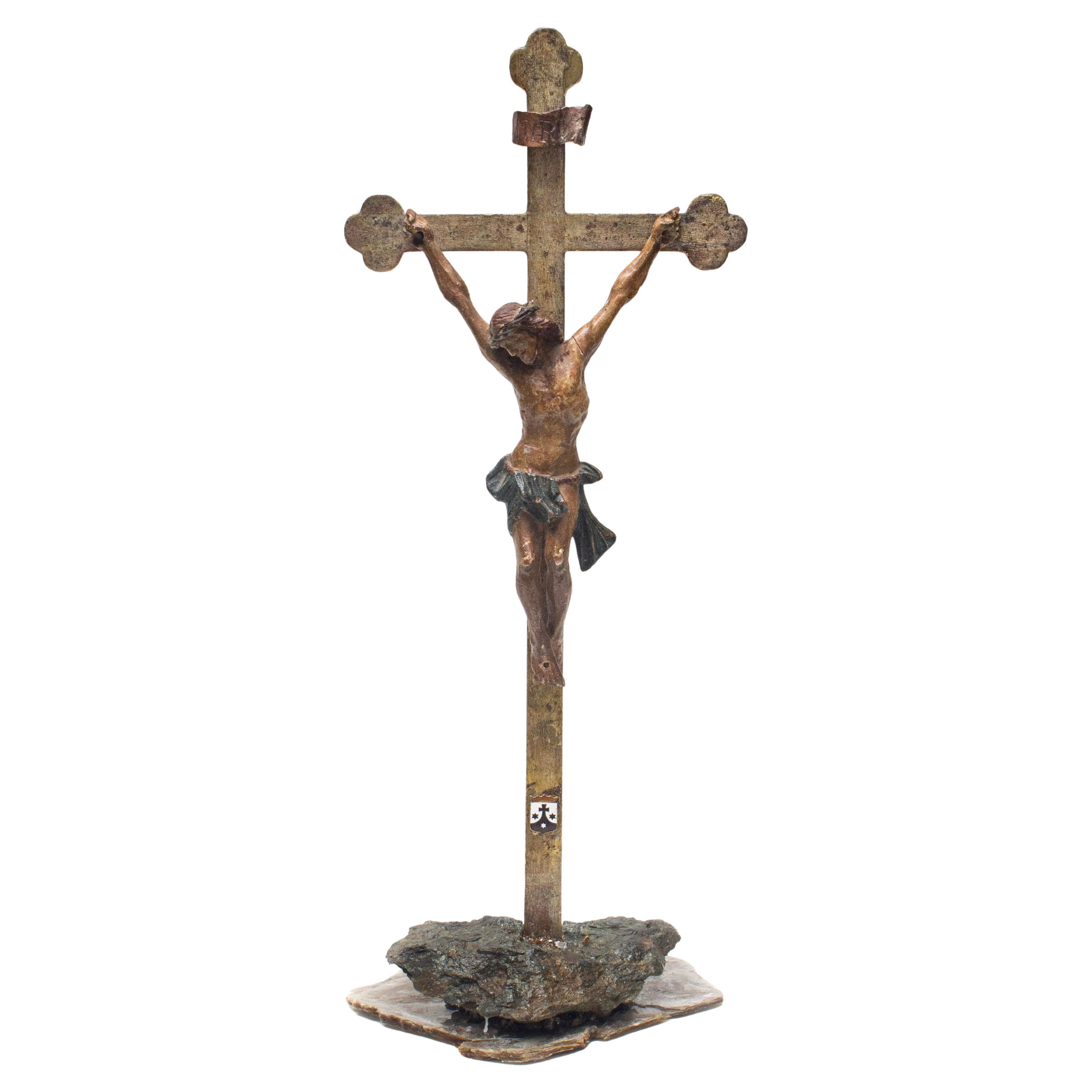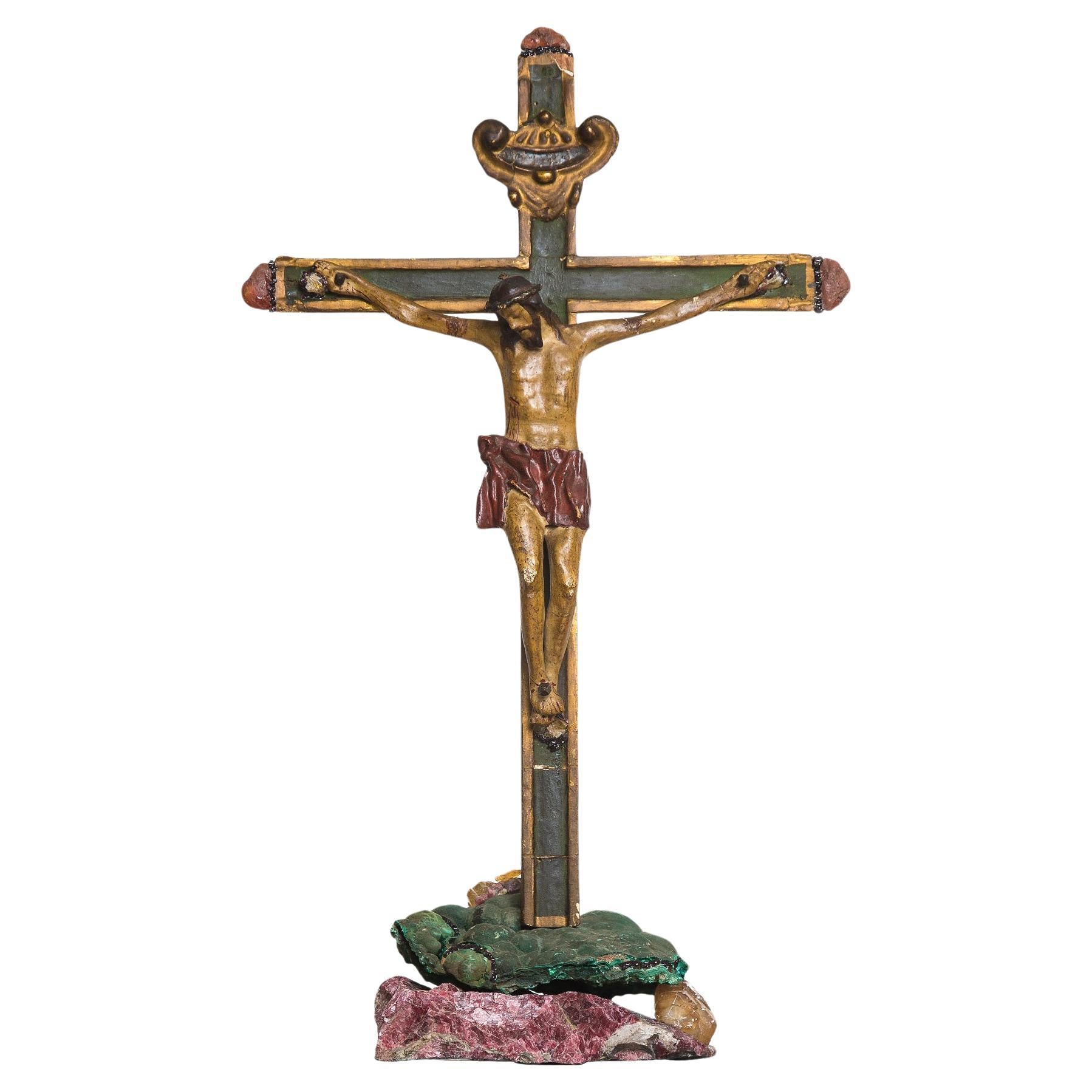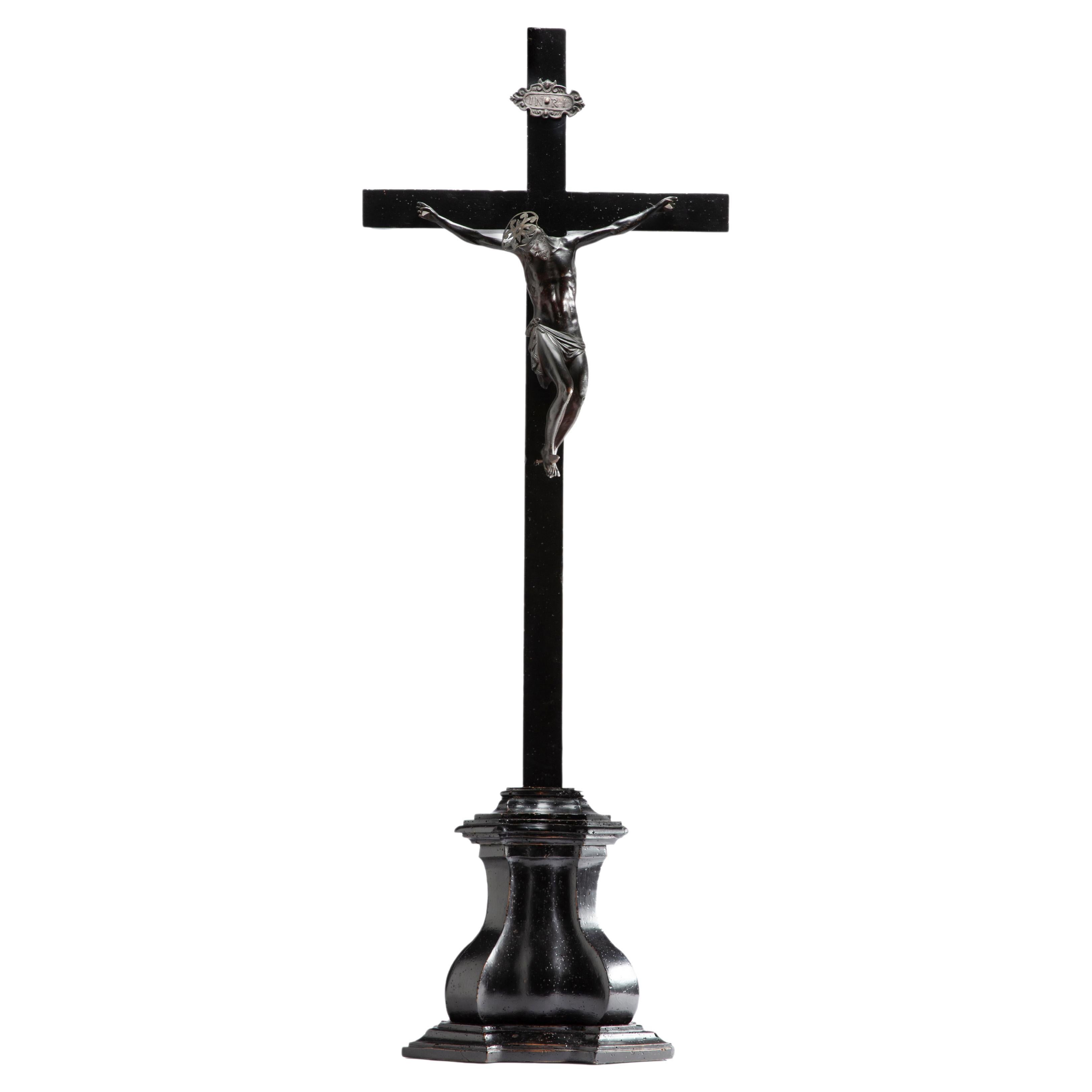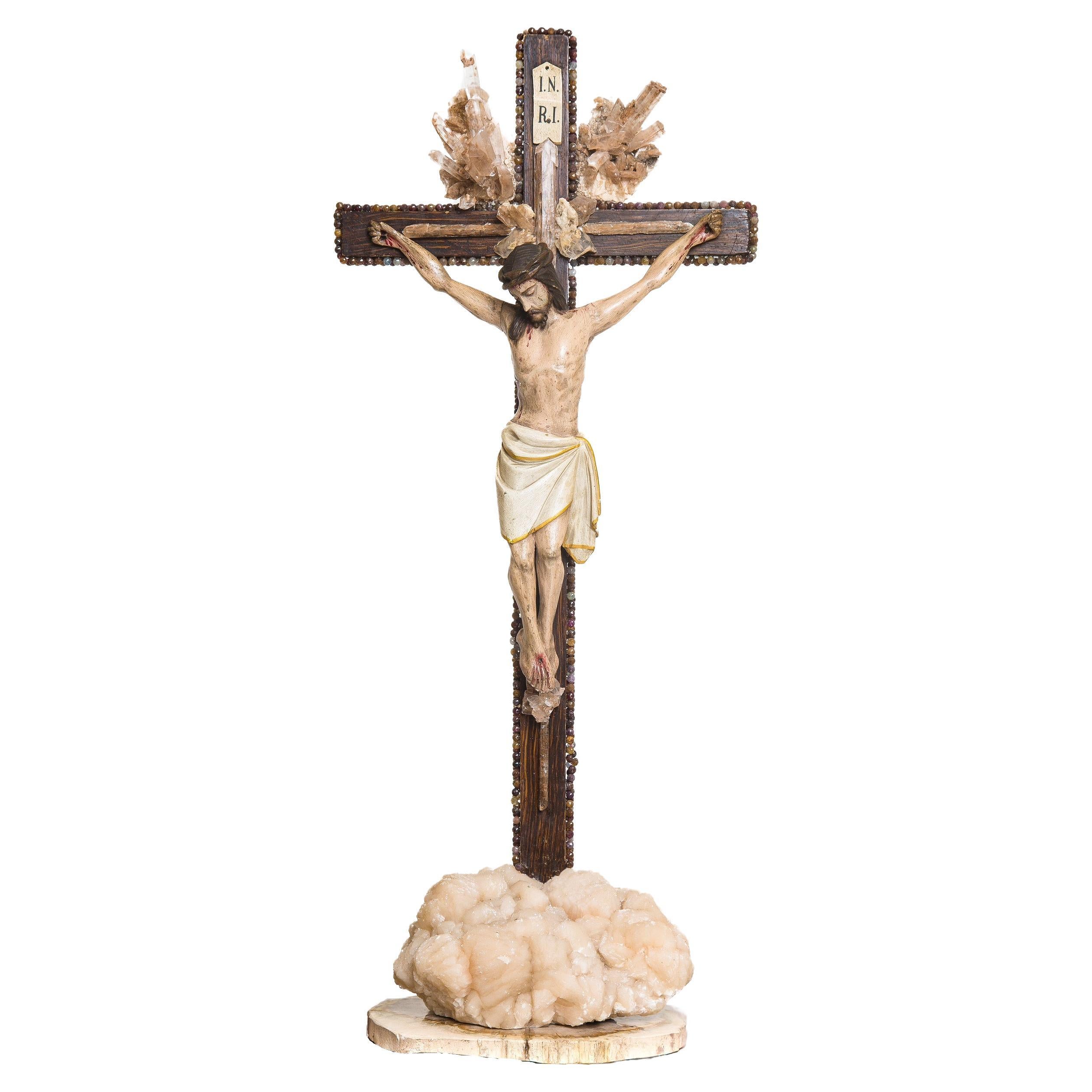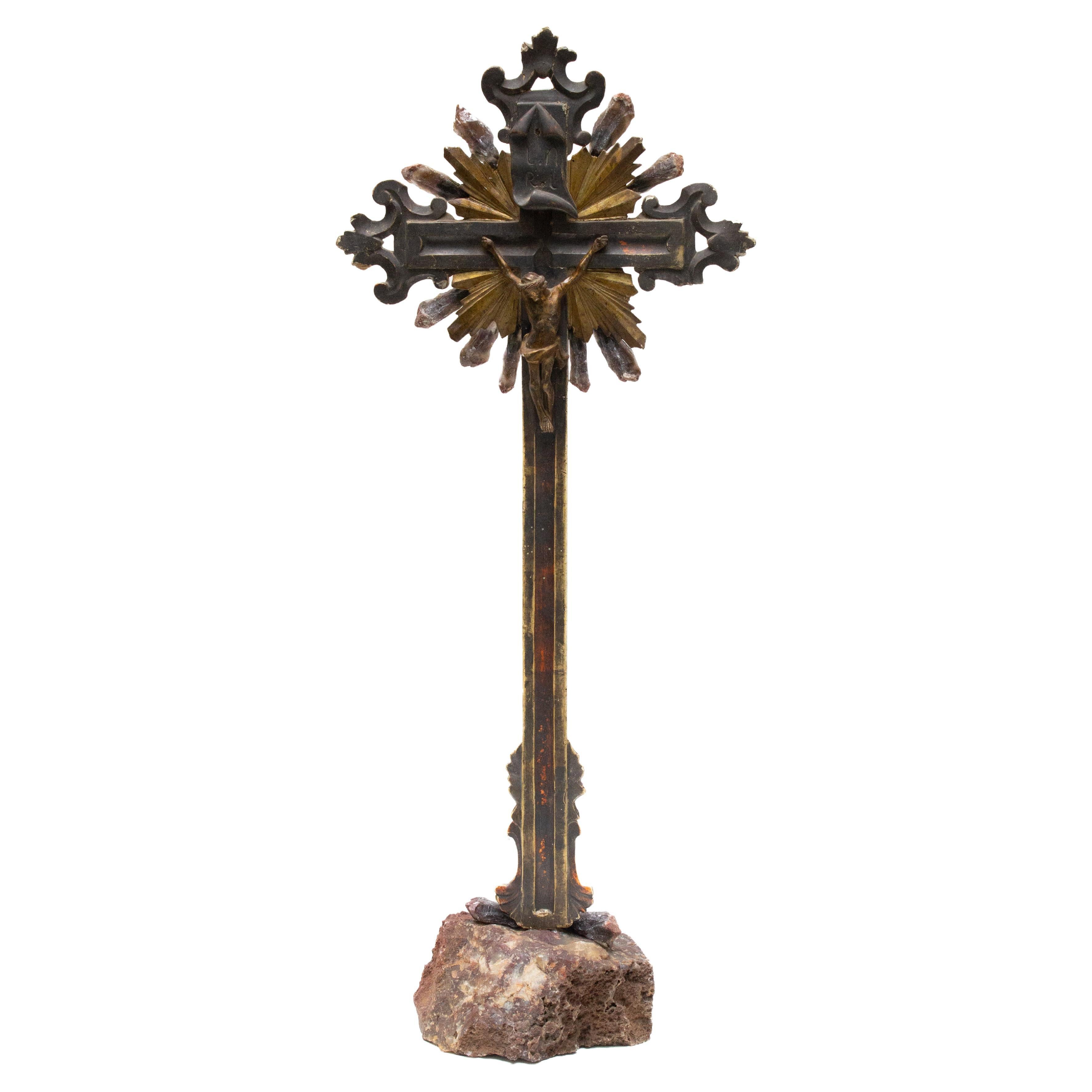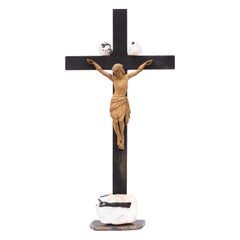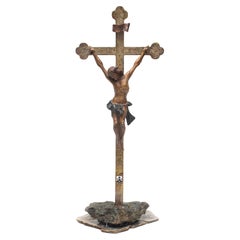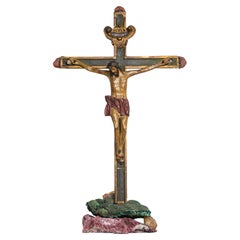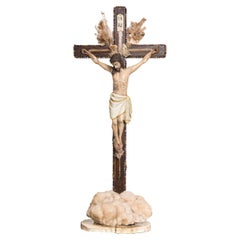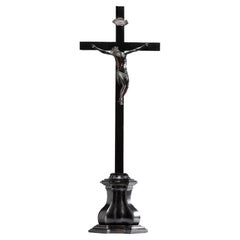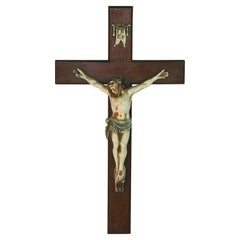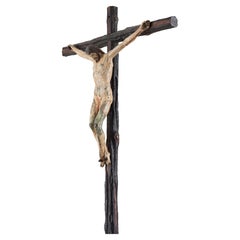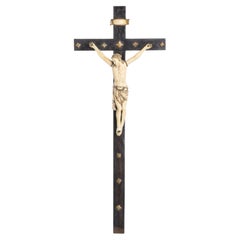Items Similar to Sculptural 18th Century Italian Black Crucifix with Tourmaline in Matrix
Want more images or videos?
Request additional images or videos from the seller
1 of 9
Sculptural 18th Century Italian Black Crucifix with Tourmaline in Matrix
$6,000
£4,591.12
€5,254.58
CA$8,473.58
A$9,209.33
CHF 4,935.36
MX$111,817.59
NOK 61,960.42
SEK 57,458.87
DKK 39,245.27
About the Item
18th century Italian crucifix adorned with tourmaline and mounted on tourmaline in a crystal matrix from Brazil.
The piece is put together by Jean O'Reilly Barlow, the artist and creative director of Interi. The date of manufacture reflects when she transformed the piece and the period shows that the Italian crucifix is originally 18th century.
The 18th century Italian crucifix is preserved and transformed into a figurative, contemporary work of art. With the combination of the precious minerals, the church artifact becomes a sculptural work of historic and organic significance.
This piece is currently exhibiting in the Museo de' Medici in Florence, Italy as part of The Crucifix Collection. The Museo de' Medici is located in the monumental Rotonda Brunelleschi which is one of the most extraordinary buildings in Florence. In addition to preserving the history of the Medici dynasty, the museum is also committed to exhibiting precious collections of works of art, historical relics, original documents, faithful reconstructions and multimedia installations.
- Creator:Interi (Artist)
- Dimensions:Height: 40 in (101.6 cm)Width: 16 in (40.64 cm)Depth: 10 in (25.4 cm)
- Style:Baroque (Of the Period)
- Materials and Techniques:
- Place of Origin:
- Period:
- Date of Manufacture:2024
- Condition:Additions or alterations made to the original: Interi transforms Italian artifacts using artistic methods and contemporary interpretations. The Italian crucifix has been put together with the natural elements to create a contemporary work of art. Wear consistent with age and use.
- Seller Location:Dublin, IE
- Reference Number:1stDibs: LU5127139123872
About the Seller
5.0
Vetted Professional Seller
Every seller passes strict standards for authenticity and reliability
Established in 2007
1stDibs seller since 2019
190 sales on 1stDibs
- ShippingRetrieving quote...Shipping from: Columbia, SC
- Return Policy
More From This Seller
View All18th Century Italian Crucifix on a Tourmaline in Crystal on a Obsidian Base
By Interi
Located in Dublin, Dalkey
18th century Italian crucifix with a hand carved figure of Christ decorated with tourmaline in crystal quartz on a polished obsidian base.
Category
Antique 18th Century Italian Rococo Figurative Sculptures
Materials
Wood
$1,387 Sale Price
25% Off
18th Century Italian Crucifix on Emerald in Matrix on Mica
By Interi
Located in Dublin, Dalkey
Sculptural 18th century Italian crucifix mounted on emerald in matrix on a reflective mica base.
The crucifix artifact is originally hand carved wood with silver leaf from a church ...
Category
Antique 18th Century Italian Baroque Mounted Objects
Materials
Rock Crystal
$1,387 Sale Price
25% Off
18th Century Italian Crucifix with Malachite, Calcite, and Raspberry Garnet
By Interi
Located in Dublin, Dalkey
18th century Italian crucifix mounted on green malachite, calcite with fluorite, and raspberry garnet. The piece is adorned with Carnelian pebbles and garnet. The minerals are from a...
Category
Antique 18th Century Italian Baroque Mounted Objects
Materials
Rock Crystal, Carnelian, Malachite
Sculptural 18th Century Italian Crucifix with Selenite Sunrays and Apophyllite
By Interi
Located in Dublin, Dalkey
Sculptural 18th century Italian crucifix with selenite in matrix and adorned with gem beading around the cross. The selenite in matrix creates the sunrays around the crucifix. The pi...
Category
Antique 18th Century Italian Rococo Mounted Objects
Materials
Rock Crystal
Sculptural 18th Century Italian Crucifix Mounted on Jasper with Crystal Points
By Interi
Located in Dublin, Dalkey
Sculptural 18th century Italian crucifix mounted on jasper with crystal points. The crystal points create more sunrays around the halo of the crucifix. The reddish tips of the crysta...
Category
Antique 18th Century Italian Rococo Mounted Objects
Materials
Agate, Coral, Rock Crystal
19th Century French Marbleized Painted Crucifix with Green Mica
By Interi
Located in Dublin, Dalkey
19th century French marbleized painted crucifix with green mica.
The crucifix originally came from a collector in France. The crucifix is painted ...
Category
Antique 19th Century French Neoclassical Revival Figurative Sculptures
Materials
Rock Crystal, Silver
You May Also Like
Crucifix, Bronze, iron, and wood, Lombardy, mid-17th century
Located in Milano, IT
Crucifix
Lombardy, mid-17th century
Bronze, iron, and wood
Sculpture: 33 cm height x 35 cm width x 10 cm depth at the knees;
Cross: 42.12 in height x 19.68 in width (107 cm x 50);
Ba...
Category
Antique Mid-17th Century Italian Baroque Figurative Sculptures
Materials
Bronze, Iron
Antique Italian Wood and Handpainted Metal Crucifix
Located in Douglas Manor, NY
1842 Antique Itaian wood and painted metal crucifix
Category
Vintage 1940s Figurative Sculptures
Materials
Metal
Rare and important painted bronze Crucifix after a model by Michelangelo
By Michelangelo Buonarroti
Located in Leesburg, VA
A rare and very fine bronze corpus of Christ after a model by Michelangelo, cast ca. 1597-1600 by Juan Bautista Franconio and painted in 1600 by Francisco Pacheco in Seville, Spain.
The present corpus reproduces a model attributed to Michelangelo. The best known example, lesser in quality, is one on display at the Metropolitan Museum of Art (MET).
The association of this corpus with Michelangelo was first brought to light by Manuel Gomez-Moreno (1930-33) who studied the wider circulated casts identified throughout Spain. The attribution to Michelangelo was subsequently followed by John Goldsmith-Phillips (1937) of the MET and again by Michelangelo expert, Charles de Tolnay (1960).
While Michelangelo is best known for his monumental works, there are four documented crucifixes he made. The best known example is the large-scale wooden crucifix for the Church of Santa Maria del Santo Spirito in Florence, made in 1492 as a gift for the Prior, Giovanni di Lap Bicchiellini, for allowing him to study the anatomy of corpses at the hospital there. In 1562, Michelangelo wrote two letters to his nephew, Lionardo, indicating his intention to carve a wooden crucifix for him. In 1563 a letter between Lionardo and the Italian sculptor Tiberio Calcagni, mentions this same crucifix (a sketch of a corpus on the verso of a sheet depicting Michelangelo’s designs for St. Peter’s Basillica [Palais des Beaux-Arts in Lille] may reproduce this). That Michelangelo was working on small corpora in the last years of his life is further evidenced by the small (26.5 cm) unfinished wooden crucifix located at the Casa Buonarroti, considered his last known sculptural undertaking. Michelangelo’s contemporary biographer, Giorgio Vasari additionally cites that Michelangelo, in his later years, made a small crucifix for his friend, Menighella, as a gift.
Surviving sketches also indicate Michelangelo’s study of this subject throughout his career, most notably during the end of his life but also during the 1530s-40s as he deepened his spiritual roots. The occasional cameo of crucified Christ’s throughout his sketched oeuvre have made it challenging for scholars to link such sketches to any documented commissions of importance. All the while, in consideration that such objects were made as gifts, it is unlikely they should be linked with commissions.
Nonetheless, a number of theories concerning Michelangelo’s sketches of Christ crucified have been proposed and some may regard the origin of the present sculpture. It has been suggested that the corpus could have its impetus with Michelangelo’s work on the Medici Chapel, whose exclusive design was given to the master. It is sensible smaller details, like an altar cross, could have fallen under his responsibility (see for example British Museum, Inv. 1859,0625.552). Others have noted the possibility of an unrealized large marble Crucifixion group which never came to fruition but whose marble blocks had been measured according to a sheet at the Casa Buonarroti.
A unique suggestion is that Michelangelo could have made the crucifix for Vittoria Colonna, of whom he was exceedingly fond and with whom he exchanged gifts along with mutual spiritual proclivities. In particular, Vittoria had an interest in the life of St. Bridget, whose vision of Christ closely resembles our sculpture, most notably with Christ’s proper-left leg and foot crossed over his right, an iconography that is incredibly scarce for crucifixes. The suggestion could add sense to Benedetto Varchi’s comment that Michelangelo made a sculpted “nude Christ…he gave to the most divine Marchesa of Pescara (Vittoria Colonna).”
Of that same period, two sketches can be visually linked to our sculpture. Tolnay relates it to a sketch of a Crucified Christ at the Teylers Museum (Inv. A034) of which Paul Joannides comments on its quality as suggestive of preparations for a sculptural work. Joannides also calls attention to a related drawing attributed to Raffaello da Montelupo copying what is believed to be a lost sketch by Michelangelo. Its relationship with our sculpture is apparent. Montelupo, a pupil of Michelangelo’s, returned to Rome to serve him in 1541, assisting with the continued work on the tomb of Pope Julius II, suggesting again an origin for the corpus ca. 1540.
The earliest firm date that can be given to the present corpus is 1574 where it appears as a rather crudely conceived Crucifixion panel, flanked by two mourners in low-relief and integrally cast for use as the bronze tabernacle door to a ciborium now located at the Church of San Lorenzo in Padula. Etched in wax residue on the back of the door is the date, 27 January 1574, indicating the corpus would have at least been available as a model by late 1573.
The Padula tabernacle was completed by Michelangelo’s assistant, Jacopo del Duca and likely has its origins with Michelangelo’s uncompleted tabernacle for the Basilica of St. Mary of the Angels in Rome.
The impetus for the Padula tabernacle’s Crucifixion panel begins with a series of late Crucifixion sketches by Michelangelo, depicting a scene of Christ crucified and flanked by two mourners (see British Museum Inv. 1895.0915.510; Ashmolean Museum Inv. 1846.89, KP II 343 recto; Windsor Castle RCIN 912761 recto; and Louvre Inv. 700). A faintly traced block possibly intended for sculpting the sketch of the crucified Christ on its recto was discovered by Tolnay on a version of the composition at Windsor Castle. The Windsor sketch and those related to it appear to have served as preparatory designs for what was probably intended to become the Basilica of St. Mary’s tabernacle door. Vasari documents that the project was to be designed by Michelangelo and cast by his assistant, Jacopo del Duca. Michelangelo died before the commission was complete, though on 15 March 1565, Jacopo writes to Michelangelo’s nephew stating, “I have started making the bronze tabernacle, depending on the model of his that was in Rome, already almost half complete.” Various circumstances interrupted the completion of the tabernacle, though its concept is later revitalized by Jacopo during preparations to sell a tabernacle, after Michelangelo’s designs, to Spain for Madrid’s El Escorial almost a decade later. The El Escorial tabernacle likewise encountered problems and was aborted but Jacopo successfully sold it shortly thereafter to the Carthusians of Padula.
An etched date, 30 May 1572, along the base of the Padula tabernacle indicates its framework was already cast by then. A 1573 summary of the tabernacle also describes the original format for the door and relief panels, intended to be square in dimension. However, a last minute decision to heighten them was abruptly made during Jacopo’s negotiations to sell the tabernacle to King Phillip II of Spain. Shortly thereafter the commission was aborted. Philippe Malgouyres notes that the Padula tabernacle’s final state is a mixed product of the original design intended for Spain’s El Escorial, recycling various parts that had already been cast and adding new quickly finished elements for its sale to Padula, explaining its unusually discordant quality, particularly as concerns the crudeness of the door and relief panels which were clearly made later (by January 1574).
Apart from his own admission in letters to Spain, it is apparent, however, that Jacopo relied upon his deceased master’s designs while hastily realizing the Padula panels. If Michelangelo had already earlier conceived a crucifix model, and Jacopo had access to that model, its logical he could have hastily employed it for incorporation on the door panel to the tabernacle. It is worth noting some modifications he made to the model, extending Christ’s arms further up in order to fit them into the scale of the panel and further lowering his chin to his chest in order to instill physiognomic congruence. A crude panel of the Deposition also follows after Michelangelo’s late sketches and is likewise known by examples thought to be modifications by Jacopo based upon Michelangelo’s initial sculptural conception (see Malgouyres: La Deposition du Christ de Jacopo del Duca, chef-d’oeuvre posthume de Michel-Ange).
Jacopo’s appropriation of an original model by Michelangelo for more than one relief on the Padula tabernacle adds further indication that the crucifix was not an object unique to Jacopo’s hand, as few scholars have posited, but rather belongs to Michelangelo’s original...
Category
Antique 16th Century Renaissance Figurative Sculptures
Materials
Bronze
JESUS CHRIST CRUCIFIED Cross in Exotic Wood, 19th Century Portuguese Sculpture
Located in Madrid, ES
JESUS CHRIST CRUCIFIED
Cross in exotic wood, 19th Century Portuguese sculpture
carved in ivor...
Signs of use. Dim. Height: (christ) 16 cm; (total) 45 cm
good conditions
Category
Antique 19th Century Italian Baroque Religious Items
Materials
Wood
Italian Vintage Crucifix in Bronze and Iron
By Midcentury Italian school
Located in Milano, IT
Beautiful vintage crucifix of fine Italian manufacture from the 1950s.
The vintage crucifix was made with nickel plated iron and gilded bronze. The v...
Category
Vintage 1950s Italian Mid-Century Modern Religious Items
Materials
Bronze, Iron
$853 Sale Price
20% Off
18th Century Carved And Painted Wooden Crucifix From France
Located in Haddonfield, NJ
An early 18th Century antique hand carved and polychromed hand painted table crucifix from France with its original patina preserved.
This crucifix could possible date back as early ...
Category
Antique Early 18th Century French Baroque Sculptures and Carvings
Materials
Fruitwood
$920 Sale Price
20% Off
More Ways To Browse
De Medici
Crucifix Antique
Carved Tourmaline
Wood Crucifix
Carved Crucifix
Italian Crucifix
Wood Carved Crucifix
Hand Carved Wood Crucifix
18th Century Crucifix
Wood Hat Block
Wooden Cog
Antique Glass Film
Antique Swiss Cow Bells
Curtis Jere Sail Boat
Jere Sail Boats
Pulley Wheel
Quartz Fossil
Shell Necklace On Stand

